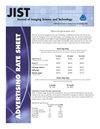SoftPrint: Investigating Haptic Softness Perception of 3D Printed Soft Object in FDM 3D Printers
IF 0.5
4区 计算机科学
Q4 IMAGING SCIENCE & PHOTOGRAPHIC TECHNOLOGY
Journal of Imaging Science and Technology
Pub Date : 2021-07-01
DOI:10.2352/j.imagingsci.technol.2021.65.4.040406
引用次数: 5
Abstract
Abstract FDM 3D printers allow massive creativity in personal products, but their potential has been limited due to inability to manipulating material properties. Previous work had demonstrated that the desired roughness could be presented simply by controlling the spatial density of tiny pins on a printed surface. This article offers a means of providing the desired softness perception of a printed surface and the desired roughness to expand the haptic dimension over which a user can exert control. Specifically, we control the softness by manipulating the infill structures of a printed surface. However, it is known that a skin contact area affects softness perception. The roughness, which is controlled by pins’ density, may also affect the perceived softness of a printed surface. Therefore, we investigate how the internal structures and the density of the pins affect softness perception. Through psychophysical experiments, we derive a computational model that estimates the perceived softness from the density of the pins and the infill density of a printed surface.SoftPrint:研究FDM 3D打印机中3D打印软对象的触觉柔软度感知
抽象FDM 3D打印机允许在个人产品中发挥巨大的创造力,但由于无法操纵材料特性,其潜力受到限制。先前的工作已经证明,只需控制印刷表面上微小引脚的空间密度,就可以获得所需的粗糙度。本文提供了一种提供印刷表面的期望柔软度感知和期望粗糙度的方法,以扩展用户可以施加控制的触觉尺寸。具体来说,我们通过操纵打印表面的填充结构来控制柔软度。然而,已知皮肤接触区域会影响柔软度感知。粗糙度由针的密度控制,也可能影响印刷表面的柔软度。因此,我们研究了引脚的内部结构和密度如何影响柔软度感知。通过心理物理学实验,我们导出了一个计算模型,该模型根据引脚的密度和印刷表面的填充密度来估计感知的柔软度。
本文章由计算机程序翻译,如有差异,请以英文原文为准。
求助全文
约1分钟内获得全文
求助全文
来源期刊

Journal of Imaging Science and Technology
工程技术-成像科学与照相技术
CiteScore
2.00
自引率
10.00%
发文量
45
审稿时长
>12 weeks
期刊介绍:
Typical issues include research papers and/or comprehensive reviews from a variety of topical areas. In the spirit of fostering constructive scientific dialog, the Journal accepts Letters to the Editor commenting on previously published articles. Periodically the Journal features a Special Section containing a group of related— usually invited—papers introduced by a Guest Editor. Imaging research topics that have coverage in JIST include:
Digital fabrication and biofabrication;
Digital printing technologies;
3D imaging: capture, display, and print;
Augmented and virtual reality systems;
Mobile imaging;
Computational and digital photography;
Machine vision and learning;
Data visualization and analysis;
Image and video quality evaluation;
Color image science;
Image archiving, permanence, and security;
Imaging applications including astronomy, medicine, sports, and autonomous vehicles.
 求助内容:
求助内容: 应助结果提醒方式:
应助结果提醒方式:


